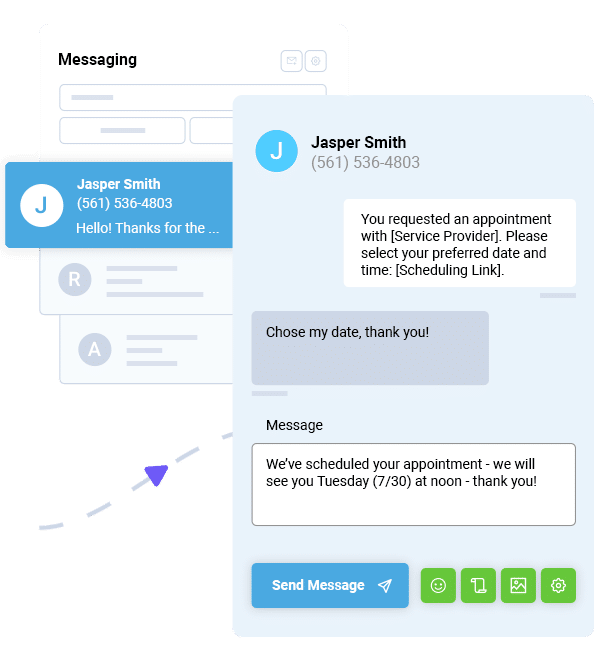Author
Tim Smith is the Media Manager at DialMyCalls, where he has leveraged his expertise in telecommunications, SaaS, SEO optimization, technical writing, and mass communication systems since 2011. Tim is a seasoned professional with over 12 years at DialMyCalls and 15+ years of online writing experience.
Try Using DialMyCalls Right Now
Start For FreeRecent Posts
- SMS Marketing Metrics: How to Measure and Improve Your Text Campaign’s Success
- What are SMS Carrier Fees and How to Lower Your Costs
- 8 Creative SMS Marketing Ideas to Boost Engagement This Summer
- 15 Ways to Use QR Codes For Event Promotion & Attendee Engagement
- Top 6 Automated Calling Service Providers For Your Business
Categories
“I am a youth minister and have spent hours in the past calling students individually to remind them of an upcoming event or to get out an urgent announcement. With DialMyCalls.com, I cut that time down to about 1 minute. I also love how I can see exactly who answered live and how long they listened so I know if they heard the whole message. DialMyCalls.com is the best website I have stumbled upon all year! Thanks!”
Central Baptist Church
Try Using DialMyCalls Right Now
Start For FreeTop 5 Strategies for Physical Therapists to Boost Patient Satisfaction
Posted by Tim Smith in Customer Reminders on March 8, 2019
Updated on February 18, 2025

Being a physical therapist is as much about understanding the human body as it is about connecting with the patient. Patient satisfaction doesn’t just happen; it’s the result of deliberate actions, effective communication, and creating an experience that leaves your patients not only healed but genuinely happy. And if there’s one thing we can be sure of, it is that satisfied patients are more likely to stick around, refer their friends, and leave glowing reviews—making your clinic the go-to spot for physical therapy.
If you’re looking for ways to crank up your patient satisfaction game, you’re in the right place. In this blog, I have shared the top five strategies that will leave your patients feeling like VIPs (Very Important Patients).
Stay Connected with Mass Notifications
Create & Send a Broadcast to Thousands in Seconds
Boost Patient Satisfaction in Your Physiotherapy with These 5 Strategies
- Prioritize Clear and Empathetic Communication
- Customize Treatment Plans for Individual Needs
- Streamline Appointment Scheduling and Follow-Ups
- Foster a Positive Clinic Environment
- Educate and Empower Patients
Prioritize Clear and Empathetic Communication
Think about it: if you don’t understand what’s happening to your body, it’s hard to trust the person in charge of fixing it. That’s why communication is the backbone of any successful physical therapy experience. I am not talking about only in-person communication but about going a step further than that. The more transparent and empathetic you are, the more your patients will trust you—and trust breeds satisfaction.
What does this look like in practice?
- Active listening: Patients want to feel heard, not rushed. Give them the space to share their concerns fully before jumping in with advice.
- Speak their language: Toss the medical jargon and use plain, relatable terms. Instead of “You’ve got a torn rotator cuff,” say, “You’ve got a little damage to the muscles that help move your shoulder. We’ll fix it together!”
- Keep them informed: Nobody likes to be left in the dark once the consultation or physiotherapy session is over. Use SMS reminders or quick follow-up messages to update them on appointments, progress, and next steps.
Pro Tip: Communication isn’t just about words—it’s about tone and body language, too. A warm smile or a reassuring pat on the shoulder can work wonders.
Customize Treatment Plans for Individual Needs
Cookie-cutter approaches might work for baking, but they have no place in physical therapy. Patients feel valued when their treatment plan is tailored to their specific goals, progress, and circumstances. Personalized care isn’t just a buzzword; it’s a subtle yet powerful weapon to ensure patient satisfaction.
How to personalize care:
- Start with a thorough assessment that digs into not just their physical condition but also their lifestyle, preferences, and goals.
- Regularly revisit and tweak the plan. Maybe your patient who started as a “weekend warrior” is ready to become a full-blown gym enthusiast. Adjust their exercises to match their progress.
- Celebrate milestones! Whether it’s regaining full range of motion or completing their first 5K, acknowledging achievements keeps patients motivated and engaged.
Here’s a real-world example:
My friend once had a patient who struggled with chronic knee pain. He designed a plan that mixed traditional therapy with her favorite activity—yoga. The result? Her knee improved, and she gained a lifelong habit she loved. That personal touch made all the difference.
Streamline Appointment Scheduling and Follow-Ups
Undoubtedly, life is hectic. If booking an appointment with your clinic feels like trying to get tickets to a sold-out concert, patients will go elsewhere. Convenience is king when it comes to satisfaction, and making the scheduling process seamless shows patients you respect their time.
Here’s how to simplify the process:
- Online booking systems: Let patients schedule appointments anytime, anywhere.
- SMS reminders: Tools like DialMyCalls can send automated texts to remind patients about their upcoming sessions.
- Follow-up messages: A simple message such as, “How are you feeling after your last session?” can show you care and also keep them engaged.
A goes-without-saying reminder: Convenience isn’t a luxury—it’s an expectation. Think of scheduling and follow-ups as the red carpet you roll out for your patients.
Foster a Positive Clinic Environment
Imagine walking into a clinic that feels like a cold, sterile hospital room versus one that feels warm, welcoming, and energetic. Which would you prefer? A positive environment can make even the most grueling therapy session feel like a breeze.
Create an atmosphere patients love:
- Keep the clinic clean, organized, and accessible. First impressions matter, and no one wants to do stretches next to a pile of dusty equipment.
- Train staff to adopt a patient-first approach. A friendly receptionist and a compassionate assistant can make patients feel valued before they even meet you.
- Focus on team morale. When your staff is happy, it reflects in their interactions with patients.
Quick Win: Small touches like playing calming music, using aromatherapy, or offering refreshing water bottles can make your clinic feel like a spa day for recovery.
Educate and Empower Patients
You’re the expert, but empowering patients with knowledge about their condition and recovery process can dramatically improve satisfaction. When patients understand what’s happening and how they can help themselves heal, they feel more in control and engaged in their journey.
Ways to educate and empower:
- Provide resources like printed guides, video tutorials, or access to webinars.
- Encourage them to ask questions—no matter how small or repetitive.
- Give actionable advice they can apply at home, like exercises, stretches, or tips to avoid re-injury.
Why it works: Patients who feel informed and involved are more likely to stick to their treatment plan. And as they see results, they’ll attribute it to your guidance and expertise. This means more referrals and increased chances of patients coming back to you in the future when they need it.
Wrapping Up!
At the end of the day, patient satisfaction boils down to making people feel cared for, understood, and supported throughout their recovery journey. By focusing on clear communication, personalized care, convenience, a positive environment, and education, you’re not just treating their injuries—you’re building trust and loyalty that lasts.
So, take a moment to evaluate your current practices. Which of these strategies can you implement or improve? Start small, and watch as your patients’ smiles (and your clinic’s reputation) grow.
If you are specifically looking to enhance patient communication, then DialMyCalls can get you there. Sign up for a free trial today, and let’s work together to make your practice the go-to for all things physiotherapy!
Mass Texting, Made Easy
Send Bulk Text Message Campaigns in Seconds




